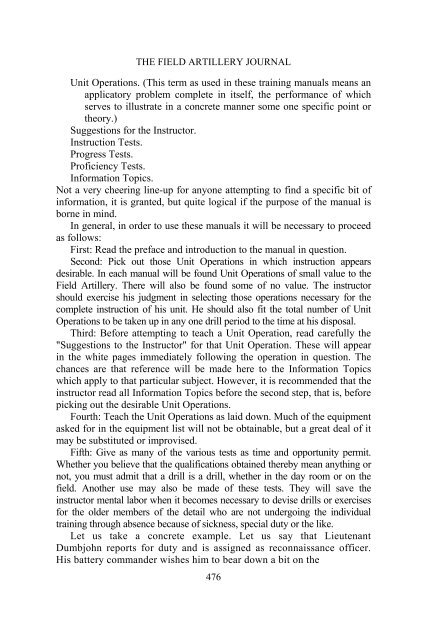september - october - Fort Sill
september - october - Fort Sill
september - october - Fort Sill
Create successful ePaper yourself
Turn your PDF publications into a flip-book with our unique Google optimized e-Paper software.
THE FIELD ARTILLERY JOURNAL<br />
Unit Operations. (This term as used in these training manuals means an<br />
applicatory problem complete in itself, the performance of which<br />
serves to illustrate in a concrete manner some one specific point or<br />
theory.)<br />
Suggestions for the Instructor.<br />
Instruction Tests.<br />
Progress Tests.<br />
Proficiency Tests.<br />
Information Topics.<br />
Not a very cheering line-up for anyone attempting to find a specific bit of<br />
information, it is granted, but quite logical if the purpose of the manual is<br />
borne in mind.<br />
In general, in order to use these manuals it will be necessary to proceed<br />
as follows:<br />
First: Read the preface and introduction to the manual in question.<br />
Second: Pick out those Unit Operations in which instruction appears<br />
desirable. In each manual will be found Unit Operations of small value to the<br />
Field Artillery. There will also be found some of no value. The instructor<br />
should exercise his judgment in selecting those operations necessary for the<br />
complete instruction of his unit. He should also fit the total number of Unit<br />
Operations to be taken up in any one drill period to the time at his disposal.<br />
Third: Before attempting to teach a Unit Operation, read carefully the<br />
"Suggestions to the Instructor" for that Unit Operation. These will appear<br />
in the white pages immediately following the operation in question. The<br />
chances are that reference will be made here to the Information Topics<br />
which apply to that particular subject. However, it is recommended that the<br />
instructor read all Information Topics before the second step, that is, before<br />
picking out the desirable Unit Operations.<br />
Fourth: Teach the Unit Operations as laid down. Much of the equipment<br />
asked for in the equipment list will not be obtainable, but a great deal of it<br />
may be substituted or improvised.<br />
Fifth: Give as many of the various tests as time and opportunity permit.<br />
Whether you believe that the qualifications obtained thereby mean anything or<br />
not, you must admit that a drill is a drill, whether in the day room or on the<br />
field. Another use may also be made of these tests. They will save the<br />
instructor mental labor when it becomes necessary to devise drills or exercises<br />
for the older members of the detail who are not undergoing the individual<br />
training through absence because of sickness, special duty or the like.<br />
Let us take a concrete example. Let us say that Lieutenant<br />
Dumbjohn reports for duty and is assigned as reconnaissance officer.<br />
His battery commander wishes him to bear down a bit on the<br />
476
















